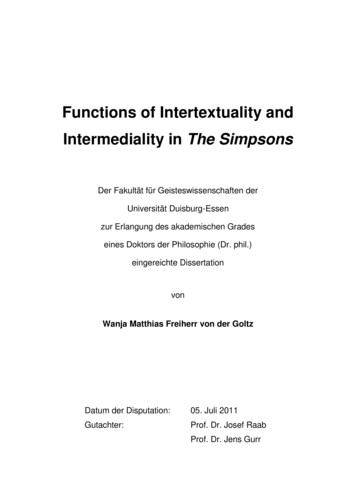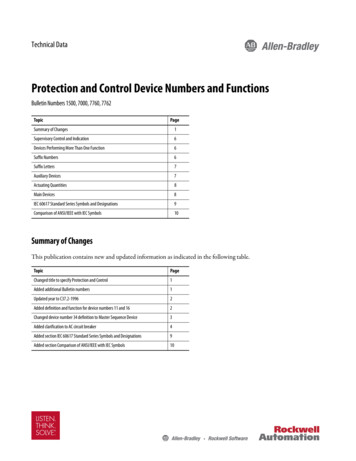
Transcription
1. Functions in PythonFunction is a block of code written to carry out a specified task. Functions provide bettermodularity and a high degree of code reusing. You can Pass Data(input) known as parameter to a function A Function may or may not return any value(Output)There are three types of functions in Python:I. Built-in functions The Python interpreter has a number of functions built into itthat are always available. They are listed here in alphabetical order.II. User-Defined Functions (UDFs): The Functions defined by User is known as UserDefined Functions. These are defined with the keyword defIII. Anonymous functions, which are also called lambda functions because they arenot declared with the standard def keyword.2.Functions vs Methods : A method refers to a function which is part ofa class. You access it with an instance or object of the class. A functiondoesn’t have this restriction: it just refers to a standalone function. Thismeans that all methods are functions, but not all functions are methods.1.1 Built-in ()Built-in rty()range()raw zip()import ()pg. 1 www.pythonclassroomdiary.wordpress.com by Sangeeta M Chuahan PGT CS, KV NO.3 Gwalior
1.2 User-Defined Functions (UDFs):Following are the rules to define a User Define Function in Python. Function begin with the keyword def followed by the function name and parentheses ( ) . Any list of parameter(s) or argument(s) should be placed within these parentheses. The first statement within a function is the documentation string of the functionor docstring is an optional statement The function block within every function starts with a colon (:) and is indented. The statement return [expression] exits a function, optionally passing back an expressionto the caller. A return statement with no arguments is the same as return None.Syntaxdef functionName( list of parameters ):" docstring"function blockreturn [expression]By default, parameters have a positional behavior and you need to inform them in thesame order that they were defined.Example for Creating a Function without parameterIn Python a function is defined using the def keyword: def MyMsg1():print("Learning to create function")Example for Creating a Function parameterThe following function takes a string as parameter and prints it on screen.docStringdef MyMsg2( name ):"This prints a passed string into this function"print (name ,’ is learning to define Python Function’)returnCalling a Function To call a function, use the function name followed byparenthesis:Calling function MyMsg1()Learning to create function MyMsg1()Output MyMsg2(‘Divyaditya’) MyMsg2(‘Manasvi’)Calling Function MyMsg2() twice with different parameterDivyaditya is learning to define Python FunctionManasvi is learning to define Python FunctionOutputpg. 2 www.pythonclassroomdiary.wordpress.com by Sangeeta M Chuahan PGT CS, KV NO.3 Gwalior
2.Parameter (argument) PassingWe can define UDFs in one of the following ways in Python1.2.3.4.Function with no argument and no Return value [ like MyMsg1(),Add() ]Function with no argument and with Return valuePython Function with argument and No Return value [like MyMsg2() ]Function with argument and Return value# Python Function with No Arguments, and No Return Value FUNCTION 1def Add1():Here we are not passing any parameter to function instead values are assigned withina 20the function and result is also printed within the function . It is not returning any valueb 30Sum a bprint("After Calling the Function:", Sum)Add1()# Python Function with Arguments, and No Return Value FUNCTION 2def Add2(a,b):Here we are passing 2 parameters a,b to the function andSum a bfunction is calculating sum of these parameter and result isprint("Result:", Sum)Add2(20,30)printed within the function . It is not returning any value# Python Function with Arguments, and Return Value FUNCTION 3def Add3(a,b):Sum a bHere we are passing 2 parameters a,b to the function and function isReturn Sumcalculating sum of these parameter and result is returned to the callingZ Add3(10,12)statement which is stored in the variable Zprint(“Result “ Z)# Python Function with No Arguments, and Return Value FUNCTION 4def Add4():a 11Here we are not passing any parameter to function instead valuesb 20are assigned within the function but result is returned.Sum a bReturn SumZ Add3(10,12)print(“Result “ Z)3.Scope : Scope of a Variable or Function may be Global orLocal3.1 Global and Local Variables in PythonGlobal variables are the one that are defined and declared outside a function and we can use them anywhere.Local variables are the one that are defined and declared inside a function/block and we can use them only within that function orblockA 50Global Varialbledef MyFunc():print("Function Called :",a)MyFunc()Function Called : 50OUTPUTpg. 3 www.pythonclassroomdiary.wordpress.com by Sangeeta M Chuahan PGT CS, KV NO.3 Gwalior
Lets understand it with another exampleSee , here Variable Local and Global is declared with the same name.a 10;Global Variable adef MyFunc1():a 20Local Variableprint("1 :",a)Value of local a will be printed as preference will be given to localdef MyFunc2():print("2 :",a)MyFunc1()MyFunc2()1 : 202 : 10Function CallOUTPUT3.2 Local /Global FunctionsGlobal Functions are the one that are defined and declared outside a function/block and we can use them anywhere.Local Function are the one that are defined and declared inside a function/block and we can use them only within thatfunction/blocka 10;def MyFunc1():# Function is globally defineda 20print("1 :",a)def MyFunc2():print("2 :",a)def SubFun1(st):# Function is Locally definedprint("Local Function with ",st)SubFun1("Local Call")Function is called LocallyMyFunc1()MyFunc2()SubFun1("Global Call")Function is called Globally will give error as function scope is within the function MyFun2()1 : 202 : 10Local Function with Local CallTraceback (most recent call last):File 36-32/funct.py", line 14, in module SubFun1("Global Call")NameError: name 'SubFun1' is not defined4. Mutable vs Immutable Objects in PythonEvery variable in python holds an instance of an object. There are two types of objects in pythoni.e. Mutable and Immutable objects. Whenever an object is instantiated, it is assigned a uniqueobject id. The type of the object is defined at the runtime and it can’t be changed afterwards.However, it’s state can be changed if it is a mutable object.To summaries the difference, mutable objects can change their state or contents and immutableobjects can’t change their state or content.pg. 4 www.pythonclassroomdiary.wordpress.com by Sangeeta M Chuahan PGT CS, KV NO.3 Gwalior
Immutable Objects : These are of in-built types like int, float, bool, string, unicode, tuple. Insimple words, an immutable object can’t be changed after it is created.# Python code to test that# tuples are immutabletuple1 (10, 21, 32, 34)tuple1[0] 41print(tuple1)Error :Traceback (most recent call last):File "e0eaddff843a8695575daec34506f126.py", line 3, intuple1[0] 41TypeError: 'tuple' object does not support item assignment# Python code to test that# strings are immutablemessage "Welcome to Learn Python"message[0] 'p'print(message)Error :Traceback (most recent call last):File "/home/ff856d3c5411909530c4d328eeca165b.py", line 3, inmessage[0] 'w'TypeError: 'str' object does not support item assignment Mutable Objects : These are of type list, dict, set . Custom classes are generally mutable.# Python code to test that# lists are mutablecolor ["red", "blue", "green"]print(color)color[0] "pink"color[-1] "orange"print(color)Output: ['red', 'blue', 'green'] ['pink', 'blue', 'orange']Conclusion1. Mutable and immutable objects are handled differently in python. Immutable objects are fastto access and are expensive to change, because it involves creation of a copy.Whereas mutable objects are easy to change.2. Use of mutable objects is recommended when there is a need to change the size or contentof the object.3. Exception : However, there is an exception in immutability as well. We know that tuple inpython is immutable. But the tuple consist of a sequence of names with unchangeablebindings to objects.Consider a tupletup ([3, 4, 5], 'myname')The tuple consist of a string and a list. Strings are immutable so we can’t change it’s value.But the contents of the list can change. The tuple itself isn’t mutable but contain itemsthat are mutable.pg. 5 www.pythonclassroomdiary.wordpress.com by Sangeeta M Chuahan PGT CS, KV NO.3 Gwalior
5. Passing arguments and returning valuesReference : Introduction to Programming in Python: An Interdisciplinary Approach By Robert Sedgewick, RobertDondero, Kevin WayneNext, we examine the specifics of Python’s mechanisms for passing arguments to and returning values from functions. Thesemechanisms are conceptually very simple, but it is worthwhile to take the time to understand them fully, as the effects areactually profound. Understanding argument-passing and return-value mechanisms is key to learning any new programminglanguage. In the case of Python, the concepts of immutability and aliasing play a central role.Call by object reference You can use parameter variables anywhere in the body of the function in the same wayas you use local variables. The only difference between a parameter variable and a local variable is that Python initializesthe parameter variable with the corresponding argument provided by the calling code. We refer to this approach as call byobject reference. (It is more commonly known as call by value, where the value is always an object reference—not theobject’s value.) One consequence of this approach is that if a parameter variable refers to a mutable object and you changethat object’s value within a function, then this also changes the object’s value in the calling code (because it is the sameobject). Next, we explore the ramifications of this approach.Immutability and aliasing Arrays are mutable data types, because we can change array elements. By contrast, adata type is immutable if it is not possible to change the value of an object of that type. The other data types that we havebeen using (int, float, str, and bool) are all immutable. In an immutable data type, operations that might seem to change avalue actually result in the creation of a new object, as illustrated in the simple example at right. First, the statement i 99 creates an integer99, and assigns to i a reference to that integer. Then j i assigns i (an object reference) to j, soboth i and j reference the same object—the integer 99. Two variables that reference the same objects are said to be aliases.Next, j 1 results in j referencing an object with value 100, but it does not do so by changing the value of the existinginteger from 99 to 100! Indeed, since int objects are immutable, no statement can change the value of that existing integer.Instead, that statement creates a new integer 1, adds it to the integer 99 to create another new integer 100, and assignsto j a reference to that integer. But i still references the original 99. Note that the new integer 1 has no reference to it in theend—that is the system’s concern, not ours. The immutability of integers, floats, strings, and booleans is a fundamentalaspect of PythonIntegers, floats, Booleans, and strings as argumentsThe key point to remember about passing arguments to functions in Python is that whenever you pass arguments to afunction, the arguments and the function’s parameter variables become aliases. In practice, this is the predominant use ofaliasing in Python, and it is important to understand its effects. For purposes of illustration, suppose that we need a functionthat increments an integer (our discussion applies to any more complicated function as well). A programmer new to Pythonmight try this definition:def inc(j):j 1and then expect to increment an integer i with the call inc(i). Code like this would work in some programming languages, butit has no effect in Python, as shown in the figure at right. First, the statement i 99 assigns to global variable i a reference tothe integer 99. Then, the statement inc(i) passes i, an object reference, to the inc() function. That object reference isassigned to the parameter variable j. At this point i and j are aliases. As before, the inc() function’s j 1statement does notchange the integer 99, but rather creates a new integer 100 and assigns a reference to that integer to j. But whenthe inc() function returns to its caller, its parameter variable jgoes out of scope, and the variable i still references theinteger 99.pg. 6 www.pythonclassroomdiary.wordpress.com by Sangeeta M Chuahan PGT CS, KV NO.3 Gwalior
This example illustrates that, in Python, a function cannot produce the side effect of changing the value of an integerobject (nothing can do so). To increment variable i, we could use the definitiondef inc(j):j 1return jand call the function with the assignment statement i inc(i).The same holds true for any immutable type. A function cannot change the value of an integer, a float, a boolean, or a string.Arrays as argumentsWhen a function takes an array as an argument, it implements a function that operates on an arbitrary number of objects.For example, the following function computes the mean (average) of an array of floats or integers:def mean(a):total 0.0for v in a:total vreturn total / len(a)We have been using arrays as arguments from the beginning of the book. For example, by convention, Python collects thestrings that you type after the program name in the python command into an arraysys.argv[] and implicitly calls your globalcode with that array of strings as the argument.Side effects with arraysSince arrays are mutable, it is often the case that the purpose of a function that takes an array as argument is to produce aside effect (such as changing the order of array elements). A prototypical example of such a function is one that exchangesthe elements at two given indices in a given array. We can adapt the code that we examined at the beginning ofSECTION 1.4:def exchange(a, i, j):temp a[i]a[i] a[j]a[j] tempThis implementation stems naturally from the Python array representation. The first parameter variable in exchange() is areference to the array, not to all of the array’s elements: when you pass an array as an argument to a function, you aregiving it the opportunity to operate on that array (not a copy of it). A formal trace of a call on this function is shown on thefacing page. This diagram is worthy of careful study to check your understanding of Python’s function-call mechanism.A second prototypical example of a function that takes an array argument and produces side effects is one that randomlyshuffles the elements in the array,def shuffle(a):n len(a)for i in range(n):r random.randrange(i, n)exchange(a, i, r)#Python’s standard function random.shuffle() does the same task.pg. 7 www.pythonclassroomdiary.wordpress.com by Sangeeta M Chuahan PGT CS, KV NO.3 Gwalior
Arrays as return valuesA function that sorts, shuffles, or otherwise modifies an array taken as argument does not have to return a reference to thatarray, because it is changing the contents of a client array, not a copy. But there are many situations where it is useful for afunction to provide an array as a return value. Chief among these are functions that create arrays for the purpose ofreturning multiple objects of the same type to a client.As an example, consider the following function, which returns an array of random floats:def randomarray(n):a stdarray.create1D(n)for i in range(n):a[i] random.random()return aTHE TABLE BELOW CONCLUDES OUR DISCUSSION of arrays as function arguments by highlighting some typical array-processionfunctions.mean of an arraydot product of two vectors of the same lengthexchange two elements in an arraywrite a one-dimensional array (and its length)read a two-dimensional array of floats (with dimensions)def mean(a):total 0.0for v in a:total vreturn total / len(a)def dot(a, b):total 0for i in range(len(a)):total a[i] * b[i]return totaldef exchange(a, i, j):temp a[i]a[i] a[j]a[j] tempdef write1D(a):stdio.writeln(len(a))for v in a:stdio.writeln(v)def readFloat2D():m stdio.readInt()n stdio.readInt()a stdarray.create2D(m, n, 0.0)for i in range(m):for j in range(n):a[i][j] stdio.readFloat()return apg. 8 www.pythonclassroomdiary.wordpress.com by Sangeeta M Chuahan PGT CS, KV NO.3 Gwalior
6. FUNCTION USING LIBRARIEs:6.1 Functions in Python Math ModuleHere is the list of all the functions and attributes defined in math module with a brief explanation ofwhat they do.List of Functions in Python Math ModuleFunctionDescriptionceil(x)copysign(x, y)fabs(x)factorial(x)floor(x)fmod(x, )ldexp(x, i)modf(x)trunc(x)exp(x)expm1(x)log(x[, base])log1p(x)log2(x)log10(x)pow(x, y)sqrt(x)acos(x)asin(x)atan(x)atan2(y, x)cos(x)hypot(x, lgamma(x)Returns the smallest integer greater than or equal to x.Returns x with the sign of yReturns the absolute value of xReturns the factorial of xReturns the largest integer less than or equal to xReturns the remainder when x is divided by yReturns the mantissa and exponent of x as the pair (m, e)Returns an accurate floating point sum of values in the iterableReturns True if x is neither an infinity nor a NaN (Not a Number)Returns True if x is a positive or negative infinityReturns True if x is a NaNReturns x * (2**i)Returns the fractional and integer parts of xReturns the truncated integer value of xReturns e**xReturns e**x - 1Returns the logarithm of x to the base (defaults to e)Returns the natural logarithm of 1 xReturns the base-2 logarithm of xReturns the base-10 logarithm of xReturns x raised to the power yReturns the square root of xReturns the arc cosine of xReturns the arc sine of xReturns the arc tangent of xReturns atan(y / x)Returns the cosine of xReturns the Euclidean norm, sqrt(x*x y*y)Returns the sine of xReturns the tangent of xConverts angle x from radians to degreesConverts angle x from degrees to radiansReturns the inverse hyperbolic cosine of xReturns the inverse hyperbolic sine of xReturns the inverse hyperbolic tangent of xReturns the hyperbolic cosine of xReturns the hyperbolic cosine of xReturns the hyperbolic tangent of xReturns the error function at xReturns the complementary error function at xReturns the Gamma function at xReturns the natural logarithm of the absolute value of the Gammafunction at xMathematical constant, the ratio of circumference of a circle to it'sdiameter (3.14159.)mathematical constant e (2.71828.)piepg. 9 www.pythonclassroomdiary.wordpress.com by Sangeeta M Chuahan PGT CS, KV NO.3 Gwalior
6.1 Python has a set of built-in methods that you can use on verts the first character to upper caseConverts string into lower caseReturns a centered stringReturns the number of times a specified value occurs in a stringReturns an encoded version of the stringReturns true if the string ends with the specified valueSets the tab size of the stringSearches the string for a specified value and returns the position of where itwas foundformat()Formats specified values in a stringformat map() Formats specified values in a stringindex()Searches the string for a specified value and returns the position of where itwas foundisalnum()Returns True if all characters in the string are alphanumericisalpha()Returns True if all characters in the string are in the alphabetisdecimal()Returns True if all characters in the string are decimalsisdigit()Returns True if all characters in the string are digitsisidentifier()Returns True if the string is an identifierislower()Returns True if all characters in the string are lower caseisnumeric()Returns True if all characters in the string are numericisprintable()Returns True if all characters in the string are printableisspace()Returns True if all characters in the string are whitespacesistitle()Returns True if the string follows the rules of a titleisupper()Returns True if all characters in the string are upper casejoin()Joins the elements of an iterable to the end of the stringljust()Returns a left justified version of the stringlower()Converts a string into lower caselstrip()Returns a left trim version of the stringmaketrans()Returns a translation table to be used in translationspartition()Returns a tuple where the string is parted into three partsreplace()Returns a string where a specified value is replaced with a specified valuerfind()Searches the string for a specified value and returns the last position ofwhere it was foundrindex()Searches the string for a specified value and returns the last position ofwhere it was foundrpartition()Returns a tuple where the string is parted into three partsrsplit()Splits the string at the specified separator, and returns a listrstrip()Returns a right trim version of the stringsplit()Splits the string at the specified separator, and returns a listsplitlines()Splits the string at line breaks and returns a liststartswith()Returns true if the string starts with the specified valuestrip()Returns a trimmed version of the stringswapcase()Swaps cases, lower case becomes upper case and vice versatitle()Converts the first character of each word to upper casetranslate()Returns a translated stringupper()Converts a string into upper casezfill()Fills the string with a specified number of 0 values at the beginningNote: All string methods returns new values. They do not change the original string.pg. 10 www.pythonclassroomdiary.wordpress.com by Sangeeta M Chuahan PGT CS, KV NO.3 Gwalior
pg. 2 www.pythonclassroomdiary.wordpress.com by Sangeeta M Chuahan PGT CS, KV NO.3 Gwalior 1.2 User-Defined Functions (UDFs): Following are the rules to define a User Define Function in Python. Function begin with the keyword def followed by the function name and parentheses ( ) . Any list of pa











